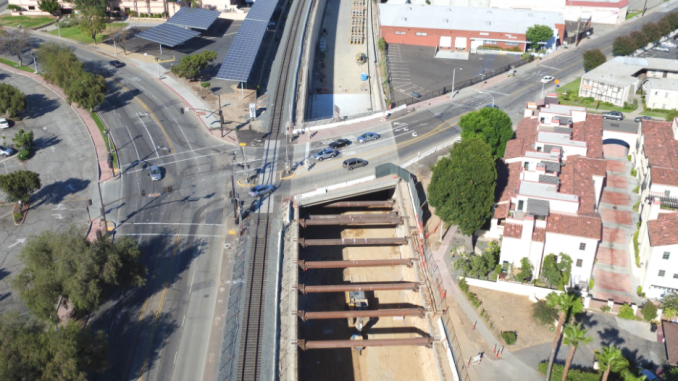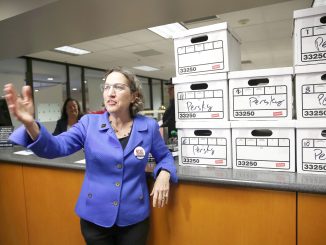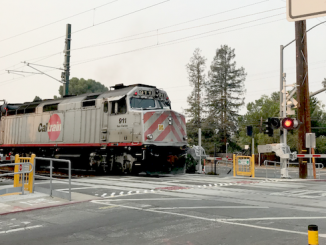
CORRECTION: An earlier version of this story incorrectly said that Stanford graduate student Alexa Russo opposed the development agreement being negotiated by Stanford and Santa Clara County supervisors. In fact, Russo said that while there are many issues that should not be addressed in the development agreement, several concerns that are not covered by the environmental and permit review processes should be included in the agreement.
BY ALLISON LEVITSKY
Daily Post Staff Writer
Several Palo Alto residents last night (Nov. 29) urged Santa Clara County leaders to get Stanford to cover the multibillion-dollar cost of burying the Caltrain tracks in a citywide trench in exchange for approval of the university’s expansion.
The demand was among many suggestions county Supervisors Joe Simitian and Cindy Chavez got during a meeting last night at Palo Alto City Hall. The supervisors wanted to hear what residents felt should be the result of the closed-door negotiations with the university over a development agreement for the expansion.
Simitian said the development agreement is a contract between the county and Stanford over public benefits that the university will provide in exchange for being allowed to expand by 2.3 million square feet, bringing 9,600 new students and workers to campus by the year 2035.
Tina Peak, a Stanford-educated veterinarian and Vice Mayor Eric Filseth’s wife, proposed a far-reaching list of demands — calling on the county to bargain so hard that the university either drastically increases the public benefits it provides or reduces its proposal to expand.
Peak, along with several other speakers, said she wanted to see Stanford foot the multibillion-dollar bill to bury the Caltrain tracks in a trench across the city.
The city still has not decided how to adapt its streets to more frequent trains expected to result from Caltrain electrification, which will start in 2021.
Peak also went beyond what the Palo Alto school board has asked for — land for a new elementary school on campus and money to build and operate it — to demand that Stanford also provide the land for a middle and high school, and to build the schools and fund their operation for the children of Stanford residents.
Peak also said she wanted to see Stanford commit to 100% carbon-neutral construction and to set aside additional open space around the Stanford Dish, Jasper Ridge and the O’Donohue Family Stanford Educational Farm.
“If that’s not enough we can come up with more,” Peak said. “We haven’t been asking for enough from them so that they will stop abusing us.”
Negotiations with Stanford to begin
The meeting was held by county planning officials along with Simitian and Chavez, who together comprise the ad hoc committee that will soon begin negotiating with Stanford over a development agreement behind closed doors.
Those benefits are meant to go beyond what Stanford is already legally required to do. In September, the Board of Supervisors approved two ordinances requiring the university to pay $155.8 million in affordable housing fees, or $68.50 per square foot of new construction and to build its affordable housing within 6 miles of the university.
Alexa Russo, a Stanford graduate student and member of the Stanford Coalition for Planning an Equitable 2030, said that while there are many issues that should not be addressed in the development agreement, several concerns that are not covered by the environmental and permit review processes should be included in the agreement.
Russo argued that the county is responsible for holding Stanford accountable for its impacts on housing and transportation and that those issues should not be “up for negotiation.”
A Stanford senior said that the university should give a one-time payment of $1 million to EPA CAN DO to fund affordable housing in East Palo Alto and to make annual $1 million payments to East Palo Alto’s affordable housing trust fund.
Other residents focused on Stanford’s environmental impacts on the foothills. Alice Kaufman, the Committee for Green Foothills’ legislative advocacy director, called on the county to make permanent the academic growth boundary that the Stanford Community Plan established in 2000 to limit development west of Junipero Serra Boulevard.
Timetable
The county is set to publish the final environmental impact report of the proposed expansion next month and hold public hearings about it between January and April.




I want Stanford to apologise to the children they made sick–I also want the people that covered this up to find new jobs somewhere else. That is all. https://www.stanforddaily.com/2015/06/02/construction-in-2013-exposed-escondido-village-residents-and-workers-to-lead/
None of these proposals address the problem with additional development at Stanford. The real problem is how to get traffic to/from the campus and Dumbarton Bridge and resolve the current gridlock that exists on University and Willow Road at commute times.
Willow Road onramps just underwent major overhauls. The city of PA doesn’t call shots re freeways…. why should Stanford pay?
If you want to solve the traffic, re zone parts of PA for multi family units. Get rid of the nimby homeowners
The City of PA runs Stanford. Do you think Cambridge residents are asking for or getting these level of concessions from Harvard? Building soccer fields, covered train grades… that’s certainly a lot of “abuse” the city is taking. Extort tech R&D and homeowners, don’t continue bleeding our founding anchor tenant
I hope Stanford doesn’t give an inch to this kind to extortion. Shameful greed on display in Palo Alto.